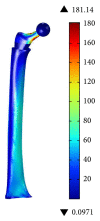Influence of PEEK Coating on Hip Implant Stress Shielding: A Finite Element Analysis
- PMID: 27051460
- PMCID: PMC4808658
- DOI: 10.1155/2016/6183679
Influence of PEEK Coating on Hip Implant Stress Shielding: A Finite Element Analysis
Abstract
Stress shielding is a well-known failure factor in hip implants. This work proposes a design concept for hip implants, using a combination of metallic stem with a polymer coating (polyether ether ketone (PEEK)). The proposed design concept is simulated using titanium alloy stems and PEEK coatings with thicknesses varying from 100 to 400 μm. The Finite Element analysis of the cancellous bone surrounding the implant shows promising results. The effective von Mises stress increases between 81 and 92% for the complete volume of cancellous bone. When focusing on the proximal zone of the implant, the increased stress transmission to the cancellous bone reaches between 47 and 60%. This increment in load transferred to the bone can influence mineral bone loss due to stress shielding, minimizing such effect, and thus prolonging implant lifespan.
Figures








References
-
- Holzwarth U., Cotogno G. JCR Scientific and Policy Reports—Total Hip Arthroplasty. European Commission; 2012.
-
- Oshkour A. A., Osman N. A. A., Bayat M., Afshar R., Berto F. Three-dimensional finite element analyses of functionally graded femoral prostheses with different geometrical configurations. Materials and Design. 2014;56:998–1008. doi: 10.1016/j.matdes.2013.12.054. - DOI
Publication types
MeSH terms
Substances
LinkOut - more resources
Full Text Sources
Other Literature Sources

